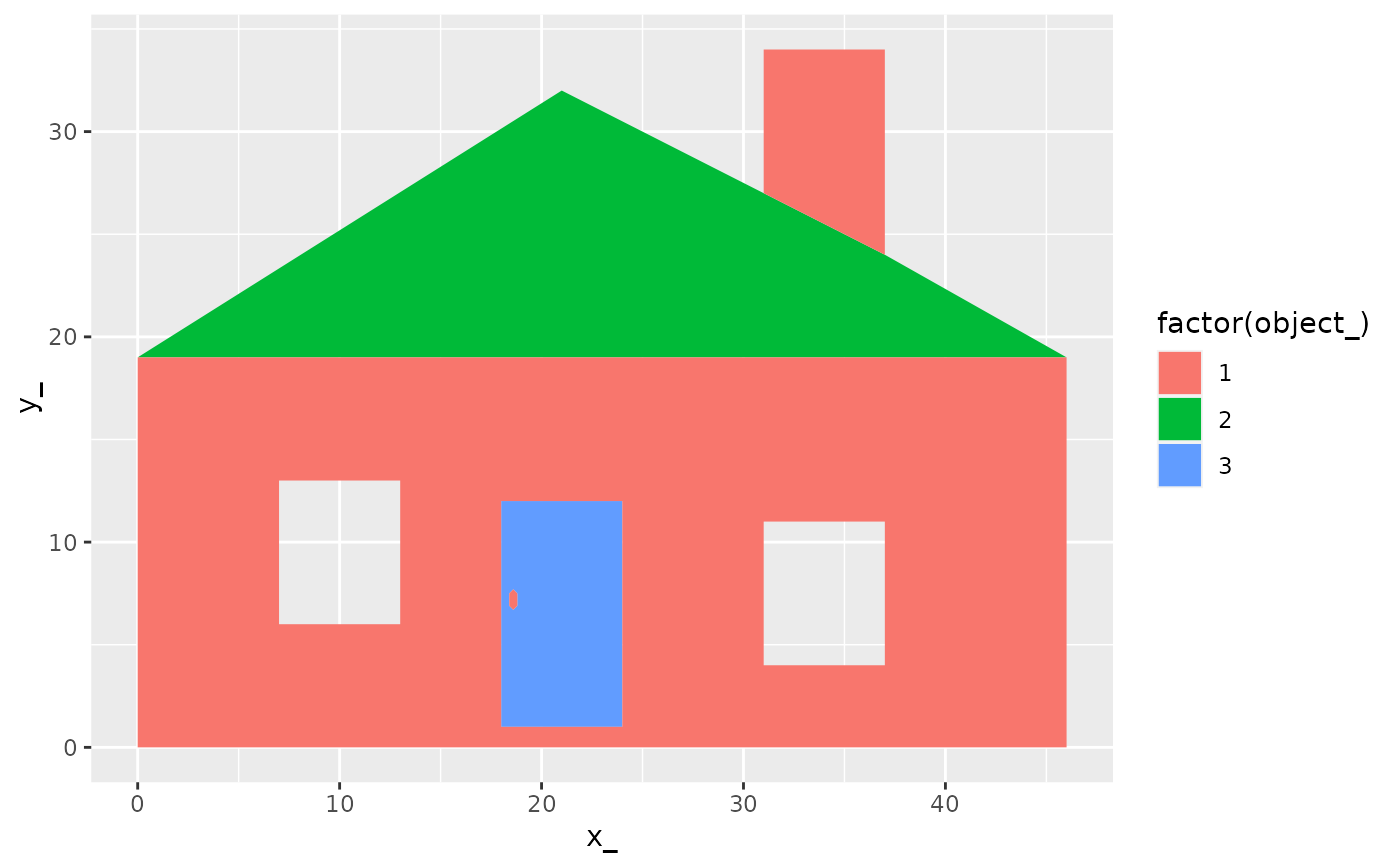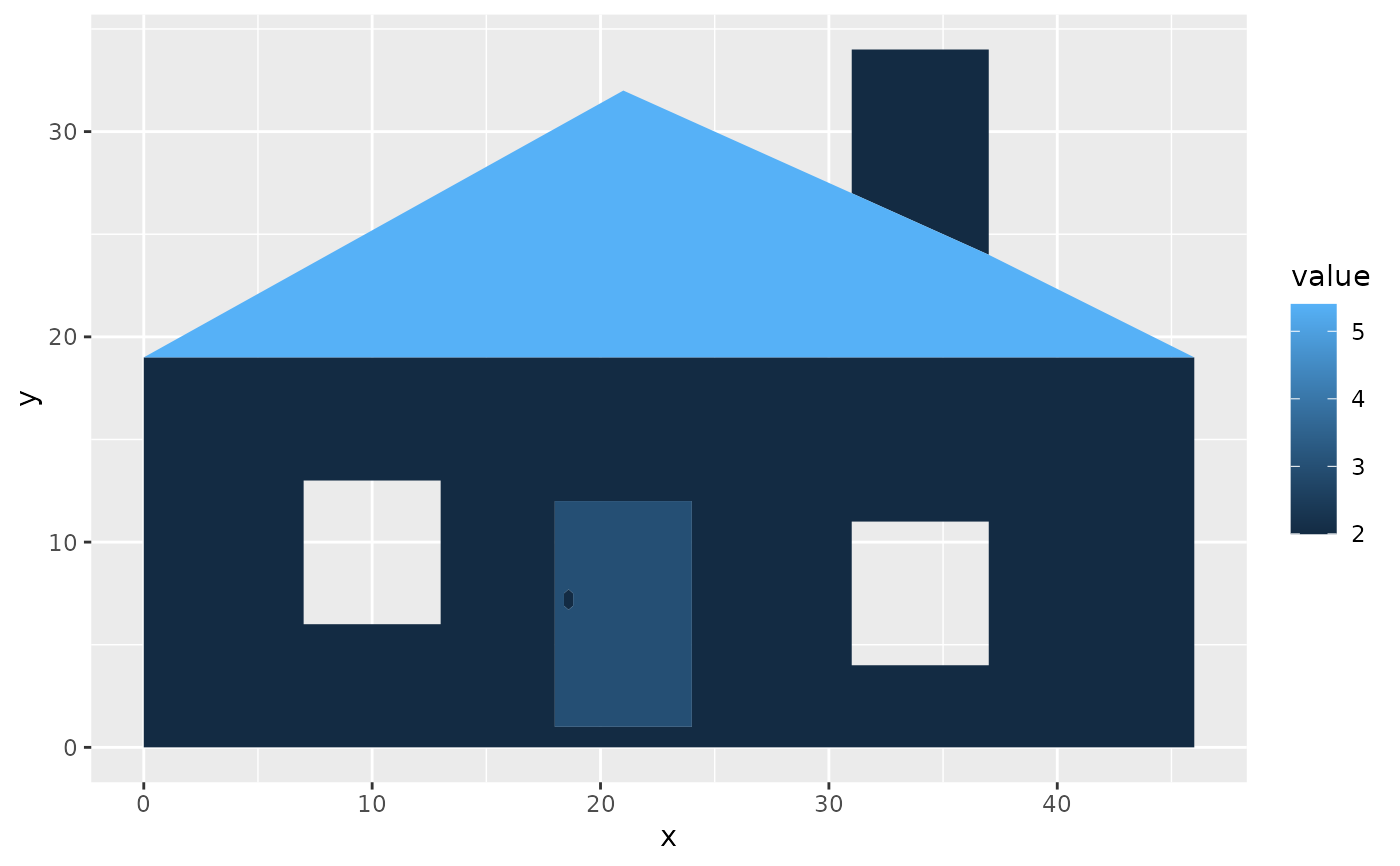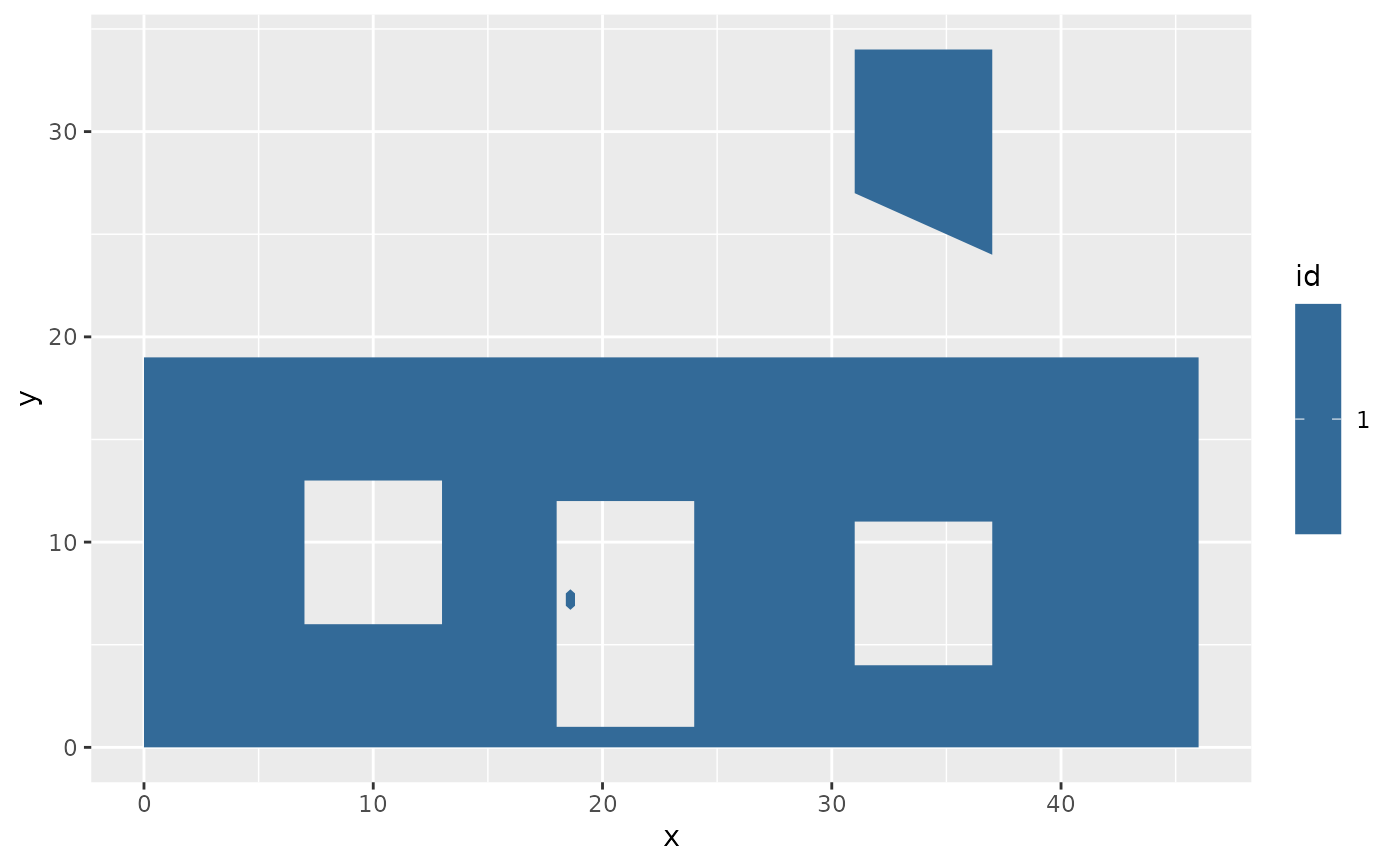Geom polypath, a polygon filled path that can include holes.
Source:R/geom_polypath.R
geom_polypath.RdPolygons are drawn by tracing a 'path' of linked vertices and applying rule to differentiate the inside and the outside of the area traversed. The 'evenodd' rule provides the normal expected behaviour seen in simple GIS geometry and is immune to self-intersections and the orientation of the path (clockwise or anti-clockwise). The 'winding' rule behaves differently for self-intersections depending on relative orientation of the interacting paths.
geom_polypath(
mapping = NULL,
data = NULL,
stat = "identity",
position = "identity",
na.rm = FALSE,
show.legend = NA,
inherit.aes = TRUE,
rule = "winding",
...
)Arguments
- mapping
Set of aesthetic mappings created by
aes(). If specified andinherit.aes = TRUE(the default), it is combined with the default mapping at the top level of the plot. You must supplymappingif there is no plot mapping.- data
The data to be displayed in this layer. There are three options:
If
NULL, the default, the data is inherited from the plot data as specified in the call toggplot().A
data.frame, or other object, will override the plot data. All objects will be fortified to produce a data frame. Seefortify()for which variables will be created.A
functionwill be called with a single argument, the plot data. The return value must be adata.frame, and will be used as the layer data. Afunctioncan be created from aformula(e.g.~ head(.x, 10)).- stat
The statistical transformation to use on the data for this layer. When using a
geom_*()function to construct a layer, thestatargument can be used the override the default coupling between geoms and stats. Thestatargument accepts the following:A
Statggproto subclass, for exampleStatCount.A string naming the stat. To give the stat as a string, strip the function name of the
stat_prefix. For example, to usestat_count(), give the stat as"count".For more information and other ways to specify the stat, see the layer stat documentation.
- position
A position adjustment to use on the data for this layer. This can be used in various ways, including to prevent overplotting and improving the display. The
positionargument accepts the following:The result of calling a position function, such as
position_jitter(). This method allows for passing extra arguments to the position.A string naming the position adjustment. To give the position as a string, strip the function name of the
position_prefix. For example, to useposition_jitter(), give the position as"jitter".For more information and other ways to specify the position, see the layer position documentation.
- na.rm
If
FALSE, the default, missing values are removed with a warning. IfTRUE, missing values are silently removed.- show.legend
logical. Should this layer be included in the legends?
NA, the default, includes if any aesthetics are mapped.FALSEnever includes, andTRUEalways includes. It can also be a named logical vector to finely select the aesthetics to display.- inherit.aes
If
FALSE, overrides the default aesthetics, rather than combining with them. This is most useful for helper functions that define both data and aesthetics and shouldn't inherit behaviour from the default plot specification, e.g.borders().- rule
character value specifying the path fill mode: either "winding" or "evenodd", see
polypath- ...
Other arguments passed on to
layer()'sparamsargument. These arguments broadly fall into one of 4 categories below. Notably, further arguments to thepositionargument, or aesthetics that are required can not be passed through.... Unknown arguments that are not part of the 4 categories below are ignored.Static aesthetics that are not mapped to a scale, but are at a fixed value and apply to the layer as a whole. For example,
colour = "red"orlinewidth = 3. The geom's documentation has an Aesthetics section that lists the available options. The 'required' aesthetics cannot be passed on to theparams. Please note that while passing unmapped aesthetics as vectors is technically possible, the order and required length is not guaranteed to be parallel to the input data.When constructing a layer using a
stat_*()function, the...argument can be used to pass on parameters to thegeompart of the layer. An example of this isstat_density(geom = "area", outline.type = "both"). The geom's documentation lists which parameters it can accept.Inversely, when constructing a layer using a
geom_*()function, the...argument can be used to pass on parameters to thestatpart of the layer. An example of this isgeom_area(stat = "density", adjust = 0.5). The stat's documentation lists which parameters it can accept.The
key_glyphargument oflayer()may also be passed on through.... This can be one of the functions described as key glyphs, to change the display of the layer in the legend.
Value
a ggplot2 layer
Details
See https://en.wikipedia.org/wiki/Even-odd_rule and https://en.wikipedia.org/wiki/Nonzero-rule for more details.
See also
polypath and pathGrob
geom_polygon for the implementation on polygonGrob,
geom_map for a convenient way to tie the values and coordinates together,
geom_path for an unfilled polygon,
geom_ribbon for a polygon anchored on the x-axis
Examples
# When using geom_polypath, you will typically need two data frames:
# one contains the coordinates of each polygon (positions), and the
# other the values associated with each polygon (values). An id
# variable links the two together.
# Normally this would not be created manually, but by using \code{\link{fortify}}
# to generate it from the Spatial classes in the `sp` package.
## the built-in data \code{\link{home}} uses nested data frames
library(ggplot2)
ggplot(maphome) + aes(x = x_, y = y_, group = branch_, fill = factor(object_)) +
geom_polypath()
 ## this is the same example built from scratch
positions = data.frame(x = c(0, 0, 46, 46, 0, 7, 13, 13, 7, 7, 18, 24,
24, 18, 18, 31, 37, 37, 31, 31, 18.4, 18.4, 18.6, 18.8, 18.8,
18.6, 18.4, 31, 31, 37, 37, 31, 0, 21, 31, 37, 46, 0, 18, 18,
24, 24, 18, 18.4, 18.6, 18.8, 18.8, 18.6, 18.4, 18.4),
y = c(0, 19, 19, 0, 0, 6, 6, 13, 13, 6, 1, 1, 12, 12, 1, 4, 4, 11, 11,
4, 6.89999999999999, 7.49999999999999, 7.69999999999999, 7.49999999999999,
6.89999999999999, 6.69999999999999, 6.89999999999999, 27, 34,
34, 24, 27, 19, 32, 27, 24, 19, 19, 1, 12, 12, 1, 1, 6.89999999999999,
6.69999999999999, 6.89999999999999, 7.49999999999999, 7.69999999999999,
7.49999999999999, 6.89999999999999),
id = c(1L, 1L, 1L, 1L, 1L, 1L, 1L, 1L, 1L, 1L, 1L, 1L, 1L, 1L, 1L, 1L,
1L, 1L, 1L, 1L, 1L, 1L, 1L, 1L, 1L, 1L, 1L, 1L, 1L, 1L, 1L, 1L, 2L, 2L,
2L, 2L, 2L, 2L, 3L, 3L, 3L, 3L, 3L, 3L, 3L, 3L, 3L, 3L, 3L, 3L),
group = c(1L, 1L, 1L, 1L, 1L, 2L, 2L, 2L, 2L, 2L, 3L, 3L, 3L, 3L, 3L, 4L,
4L, 4L, 4L, 4L, 5L, 5L, 5L, 5L, 5L, 5L, 5L, 6L, 6L, 6L, 6L, 6L, 7L,
7L, 7L, 7L, 7L, 7L, 8L, 8L, 8L, 8L, 8L, 9L, 9L, 9L, 9L, 9L, 9L, 9L))
values <- data.frame(
id = unique(positions$id),
value = c(2, 5.4, 3)
)
# manually merge the two together
datapoly <- merge(values, positions, by = c("id"))
# the entire house
(house <- ggplot(datapoly, aes(x = x, y = y)) + geom_polypath(aes(fill = value, group = group)))
## this is the same example built from scratch
positions = data.frame(x = c(0, 0, 46, 46, 0, 7, 13, 13, 7, 7, 18, 24,
24, 18, 18, 31, 37, 37, 31, 31, 18.4, 18.4, 18.6, 18.8, 18.8,
18.6, 18.4, 31, 31, 37, 37, 31, 0, 21, 31, 37, 46, 0, 18, 18,
24, 24, 18, 18.4, 18.6, 18.8, 18.8, 18.6, 18.4, 18.4),
y = c(0, 19, 19, 0, 0, 6, 6, 13, 13, 6, 1, 1, 12, 12, 1, 4, 4, 11, 11,
4, 6.89999999999999, 7.49999999999999, 7.69999999999999, 7.49999999999999,
6.89999999999999, 6.69999999999999, 6.89999999999999, 27, 34,
34, 24, 27, 19, 32, 27, 24, 19, 19, 1, 12, 12, 1, 1, 6.89999999999999,
6.69999999999999, 6.89999999999999, 7.49999999999999, 7.69999999999999,
7.49999999999999, 6.89999999999999),
id = c(1L, 1L, 1L, 1L, 1L, 1L, 1L, 1L, 1L, 1L, 1L, 1L, 1L, 1L, 1L, 1L,
1L, 1L, 1L, 1L, 1L, 1L, 1L, 1L, 1L, 1L, 1L, 1L, 1L, 1L, 1L, 1L, 2L, 2L,
2L, 2L, 2L, 2L, 3L, 3L, 3L, 3L, 3L, 3L, 3L, 3L, 3L, 3L, 3L, 3L),
group = c(1L, 1L, 1L, 1L, 1L, 2L, 2L, 2L, 2L, 2L, 3L, 3L, 3L, 3L, 3L, 4L,
4L, 4L, 4L, 4L, 5L, 5L, 5L, 5L, 5L, 5L, 5L, 6L, 6L, 6L, 6L, 6L, 7L,
7L, 7L, 7L, 7L, 7L, 8L, 8L, 8L, 8L, 8L, 9L, 9L, 9L, 9L, 9L, 9L, 9L))
values <- data.frame(
id = unique(positions$id),
value = c(2, 5.4, 3)
)
# manually merge the two together
datapoly <- merge(values, positions, by = c("id"))
# the entire house
(house <- ggplot(datapoly, aes(x = x, y = y)) + geom_polypath(aes(fill = value, group = group)))
 # just the front wall (and chimney), with its three parts, the first of which has three holes
wall <- ggplot(datapoly[datapoly$id == 1, ], aes(x = x, y = y))
wall + geom_polypath(aes(fill = id, group = group))
# just the front wall (and chimney), with its three parts, the first of which has three holes
wall <- ggplot(datapoly[datapoly$id == 1, ], aes(x = x, y = y))
wall + geom_polypath(aes(fill = id, group = group))
